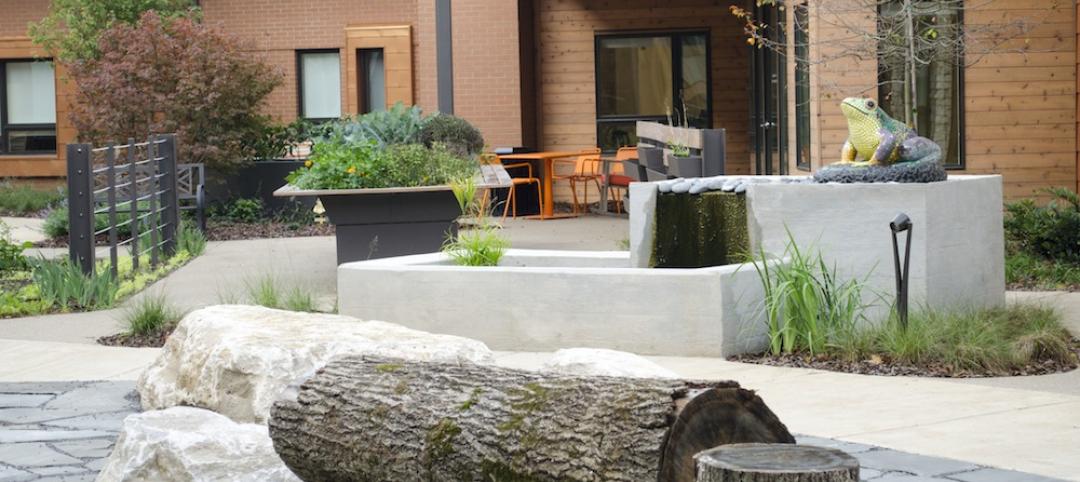This spring, the 1-million-sf Sidra Medicine in Doha, Qatar, is scheduled to launch a purpose-built clinic with in vitro fertilization services for reproductive consultation.
The hospital, which had its official opening on November 12, is one of the few in Qatar offering health services specifically for women and children. The facility, whose nearly $8 billion construction cost was endowed by Qatar Foundation, has more than 50 outpatient clinics and 400 inpatient beds, expandable to 550.
The hospital’s exterior design, by New Haven, Conn.-based Pelli Clarke Pelli Architects, is distinguished by three sails that take their cue from traditional boats known as dhows, and from sand patterns in Doha “that are quite beautiful,” says Mark Shoemaker, a Principal with Pelli Clarke Pelli. “These fluid forms inspired us.”

The hospital has three massive atriums, bathed in natural light. Image; Jeff Goldberg_Esto
The sails, clad in white ceramic tile, are part of massive atriums within the building, one of which includes a garden respite. The hospital also has a mosque, an ambulatory care center, and underground parking for 1,000 cars.
The medical center is positioned as a gateway to Education City, Doha’s 1.4-square-kilometer concentration of academic, science, and sports facilities. A tunnel connects the hospital directly to Cornell Weill Medical School, one of six campuses at Education City. (Other campuses are for Texas A&M, Carnegie Mellon University, and Virginia Commonwealth.)
The construction of Education City, which debuted in 1997, and Sidra Medicine was spearheaded by Sheikha Moza bint Nasser, chairperson of Qatar Foundation and consort to Sheikh Hamad bin Khalifa Al Thani, Qatar’s former Emir. Her Highness has been instrumental in advancing education and social reform in her country.
Shoemaker says Pelli Clarke Pelli was brought into the project by AECOM. (He once worked for Ellerbe Beckett, which designed the first Mayo Clinic. That firm is now part of AECOM). The team unveiled its design for Sidra Medical in 2007, and construction began in 2010.
Completion of the hospital was originally slated for 2011, and then 2015. The delays, explains Shoemaker, were partly attributable to the building’s size and complexity, but also to Building Team-related changes.
The hospital employs more than 4,000 people with 85 nationalities. Image: Sidra Medical and Research Center.
At one point AECOM left the project that then switched to a design-build delivery method led by Spain-based general contractor OHL, which had been in a joint venture with Contrack International for this project since 2008. Qatar Foundation fired OHL over delays in 2014, and OHL subsequently sued the foundation. Eventually, AECOM came back into the picture.
Sidra Medicine actually has been receiving patients since January 2018, and has staggered the opening of different departments—like robotic surgery last July. Shoemaker suggests this could be because Qatar doesn’t have enough trained medical professionals to meet the needs of such a large facility, and Sidra Medical has had to fill those gaps by recruiting (with Cornell Weill’s assistance) medical personnel from outside the country, mostly the United States and Europe.
When asked what his firm took away from this project, Shoemaker says that “it gave us the opportunity to experiment with different healthcare models for rooms and lobbies.” He adds that the design also paid attention to reflect Qatar’s culture.
Related Stories
Healthcare Facilities | Apr 29, 2016
How improving emergency department design leads to greater hospital efficiency
Efficient ED operations result in shorter wait times, quicker diagnosis and care plans, maximum utilization of high-cost human and physical resources, and overall better patient experiences and patient satisfaction scores, writes CBRE Healthcare's Curtis Skolnick.
Healthcare Facilities | Apr 24, 2016
A symposium in New Jersey examines how a consolidating healthcare industry can better manage its excess real estate
As service providers position themselves closer to their communities, they are looking for ways to redirect non-core buildings and land for other purposes.
Senior Living Design | Apr 14, 2016
Creating a home for eldercare using the ‘Green House’ design concept
VOA Associates’ Douglas King offers design considerations in implementing the Green House concept in eldercare for continuing care retirement communities.
Adaptive Reuse | Apr 7, 2016
Redevelopment plan announced for Chicago’s historic Cook County Hospital
The century-old, Beaux Arts architecture-inspired hospital will transform into a mixed-use development.
Industry Research | Apr 7, 2016
CBRE provides latest insight into healthcare real estate investors’ strategies
Survey respondents are targeting smaller acquisitions, at a time when market cap rates are narrowing for different product types.
Healthcare Facilities | Mar 11, 2016
Report: Hospitals’ fossil fuel use trending downward, but electricity consumption hardly declining
A new survey from engineering firm Grumman/Butkus Associates examines electricity, fossil fuel, water/sewer, and carbon footprint of healthcare facilities.
Office Buildings | Mar 9, 2016
CBRE: Workplace wellness on the rise
As insurance premiums and deductibles continue to rise, both employees and employers are evaluating options to improve their wellbeing, writes CBRE Healthcare Managing Director Craig Beam.
Healthcare Facilities | Mar 7, 2016
Can 'active' building designs make people healthier?
The new high-performance Kaiser Permanente facility in Anne Arundel County, Md., uses the built environment to improve the overall health of its occupants, writes GS&P's Terrance Perdue.
Healthcare Facilities | Mar 4, 2016
Building a home where Alzheimer’s patients can thrive
Skanska recently completed Abe’s Garden in Nashville, Tenn., a memory care community designed to improve the lives of those affected by Alzheimer’s disease. Skanska's Senior Project Manager Jeff Elpers has more on the facility.
Healthcare Facilities | Mar 1, 2016
Christ Hospital in Cincinnati brings its joint and spine care services under one roof
The opening coincides with agreements that make this center a preferred provider for several employers with self-funded healthcare plans.

















